Report on School to Work Transition: Ideologies, Policies, and PLAR
VerifiedAdded on 2023/04/21
|8
|2623
|425
Report
AI Summary
This report examines the transition from school to work, focusing on the influence of political and sociological ideologies, such as functionalism and neo-conservatism, on education policies and curriculum development in Canada. It analyzes the historical evolution of the Canadian education system, from informal learning to the modern emphasis on preparing students for the workforce. The report explores the impact of the "hidden curriculum" and the challenges in aligning apprenticeship programs with employer needs. It also discusses the significance of Prior Learning Assessment and Recognition (PLAR) schemes in higher education, highlighting the issues universities must consider when implementing them. The report concludes by emphasizing the need for government alignment with stakeholders to ensure effective curriculum development and successful transitions from school to work.
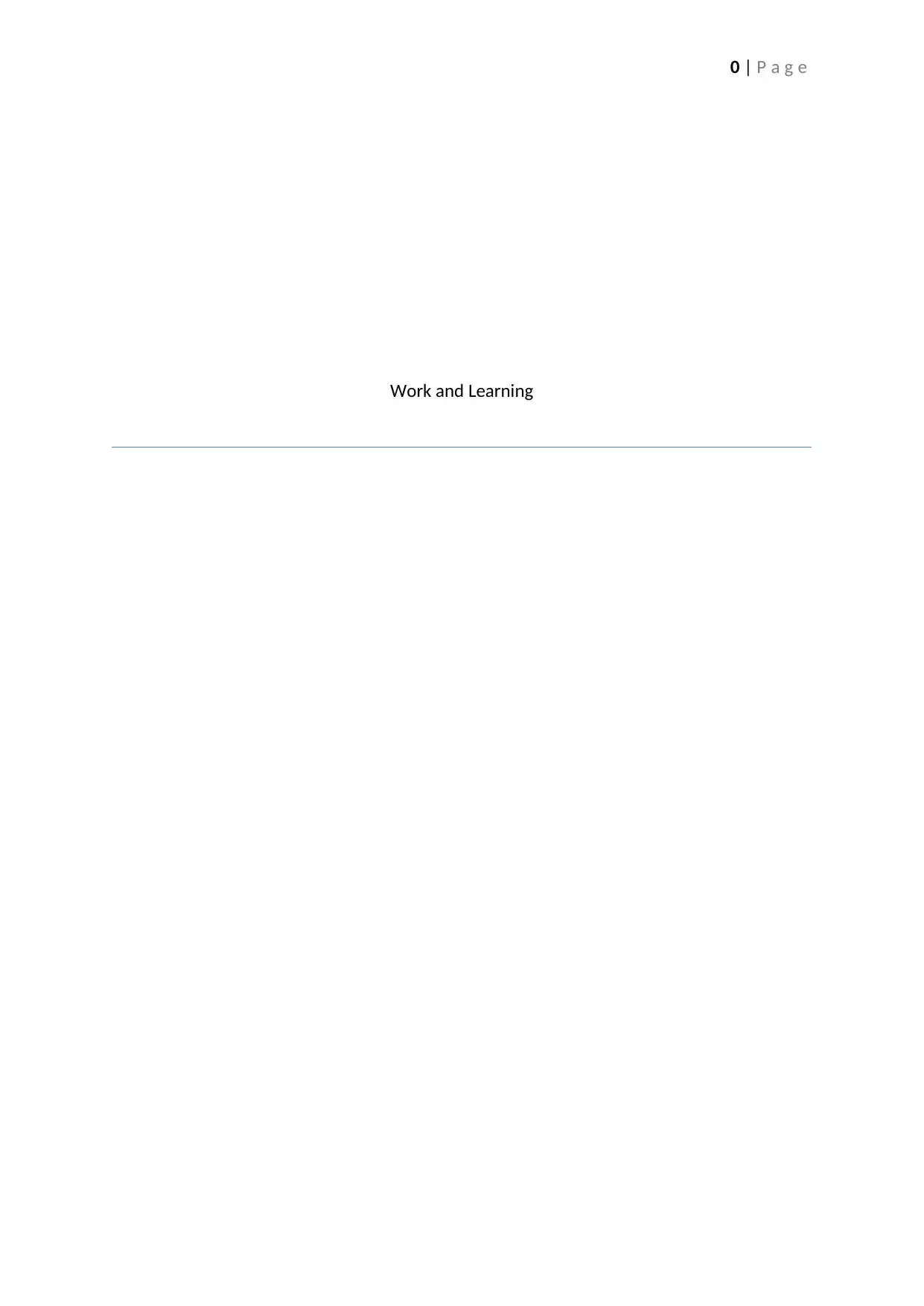
0 | P a g e
Work and Learning
Work and Learning
Paraphrase This Document
Need a fresh take? Get an instant paraphrase of this document with our AI Paraphraser
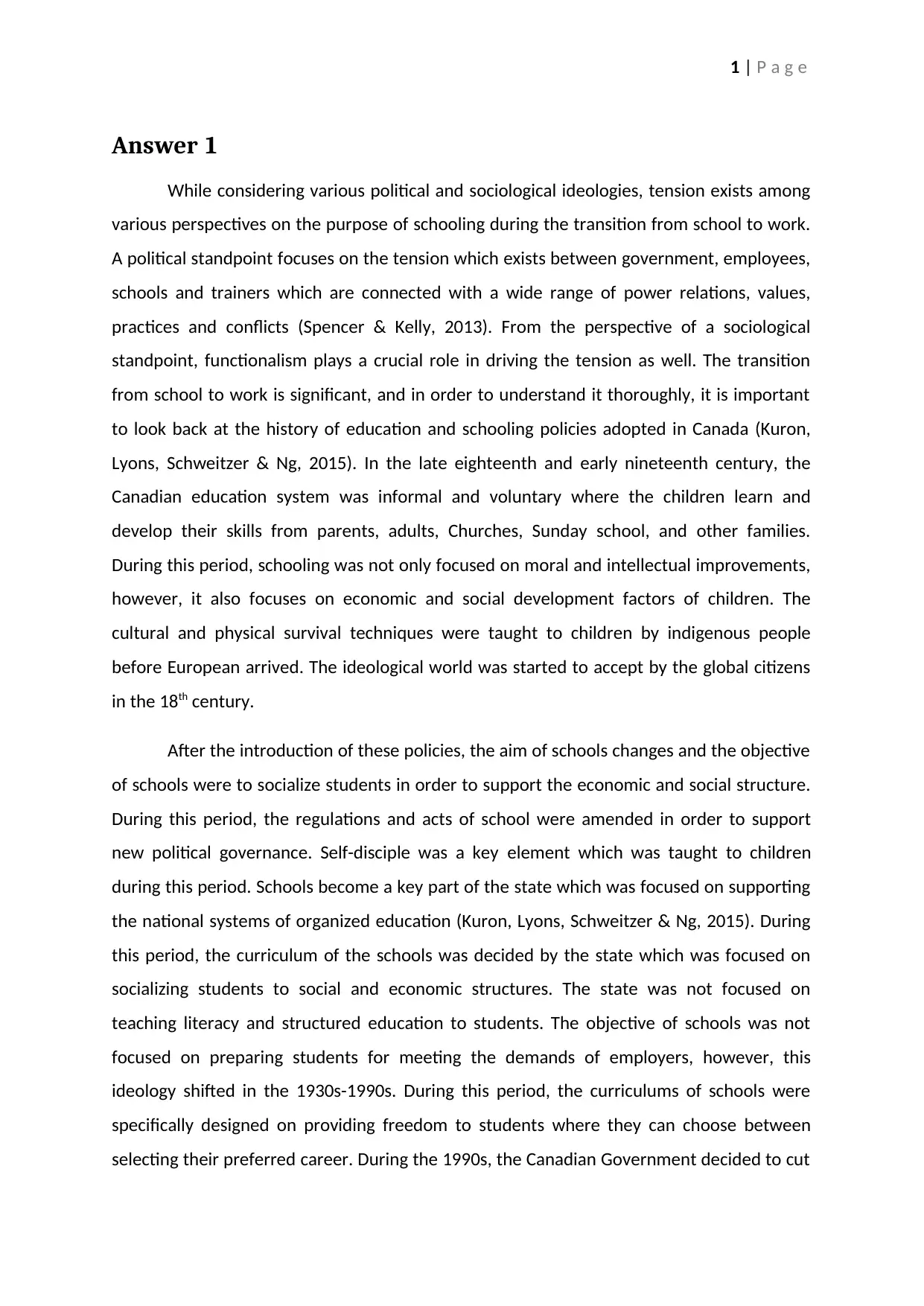
1 | P a g e
Answer 1
While considering various political and sociological ideologies, tension exists among
various perspectives on the purpose of schooling during the transition from school to work.
A political standpoint focuses on the tension which exists between government, employees,
schools and trainers which are connected with a wide range of power relations, values,
practices and conflicts (Spencer & Kelly, 2013). From the perspective of a sociological
standpoint, functionalism plays a crucial role in driving the tension as well. The transition
from school to work is significant, and in order to understand it thoroughly, it is important
to look back at the history of education and schooling policies adopted in Canada (Kuron,
Lyons, Schweitzer & Ng, 2015). In the late eighteenth and early nineteenth century, the
Canadian education system was informal and voluntary where the children learn and
develop their skills from parents, adults, Churches, Sunday school, and other families.
During this period, schooling was not only focused on moral and intellectual improvements,
however, it also focuses on economic and social development factors of children. The
cultural and physical survival techniques were taught to children by indigenous people
before European arrived. The ideological world was started to accept by the global citizens
in the 18th century.
After the introduction of these policies, the aim of schools changes and the objective
of schools were to socialize students in order to support the economic and social structure.
During this period, the regulations and acts of school were amended in order to support
new political governance. Self-disciple was a key element which was taught to children
during this period. Schools become a key part of the state which was focused on supporting
the national systems of organized education (Kuron, Lyons, Schweitzer & Ng, 2015). During
this period, the curriculum of the schools was decided by the state which was focused on
socializing students to social and economic structures. The state was not focused on
teaching literacy and structured education to students. The objective of schools was not
focused on preparing students for meeting the demands of employers, however, this
ideology shifted in the 1930s-1990s. During this period, the curriculums of schools were
specifically designed on providing freedom to students where they can choose between
selecting their preferred career. During the 1990s, the Canadian Government decided to cut
Answer 1
While considering various political and sociological ideologies, tension exists among
various perspectives on the purpose of schooling during the transition from school to work.
A political standpoint focuses on the tension which exists between government, employees,
schools and trainers which are connected with a wide range of power relations, values,
practices and conflicts (Spencer & Kelly, 2013). From the perspective of a sociological
standpoint, functionalism plays a crucial role in driving the tension as well. The transition
from school to work is significant, and in order to understand it thoroughly, it is important
to look back at the history of education and schooling policies adopted in Canada (Kuron,
Lyons, Schweitzer & Ng, 2015). In the late eighteenth and early nineteenth century, the
Canadian education system was informal and voluntary where the children learn and
develop their skills from parents, adults, Churches, Sunday school, and other families.
During this period, schooling was not only focused on moral and intellectual improvements,
however, it also focuses on economic and social development factors of children. The
cultural and physical survival techniques were taught to children by indigenous people
before European arrived. The ideological world was started to accept by the global citizens
in the 18th century.
After the introduction of these policies, the aim of schools changes and the objective
of schools were to socialize students in order to support the economic and social structure.
During this period, the regulations and acts of school were amended in order to support
new political governance. Self-disciple was a key element which was taught to children
during this period. Schools become a key part of the state which was focused on supporting
the national systems of organized education (Kuron, Lyons, Schweitzer & Ng, 2015). During
this period, the curriculum of the schools was decided by the state which was focused on
socializing students to social and economic structures. The state was not focused on
teaching literacy and structured education to students. The objective of schools was not
focused on preparing students for meeting the demands of employers, however, this
ideology shifted in the 1930s-1990s. During this period, the curriculums of schools were
specifically designed on providing freedom to students where they can choose between
selecting their preferred career. During the 1990s, the Canadian Government decided to cut
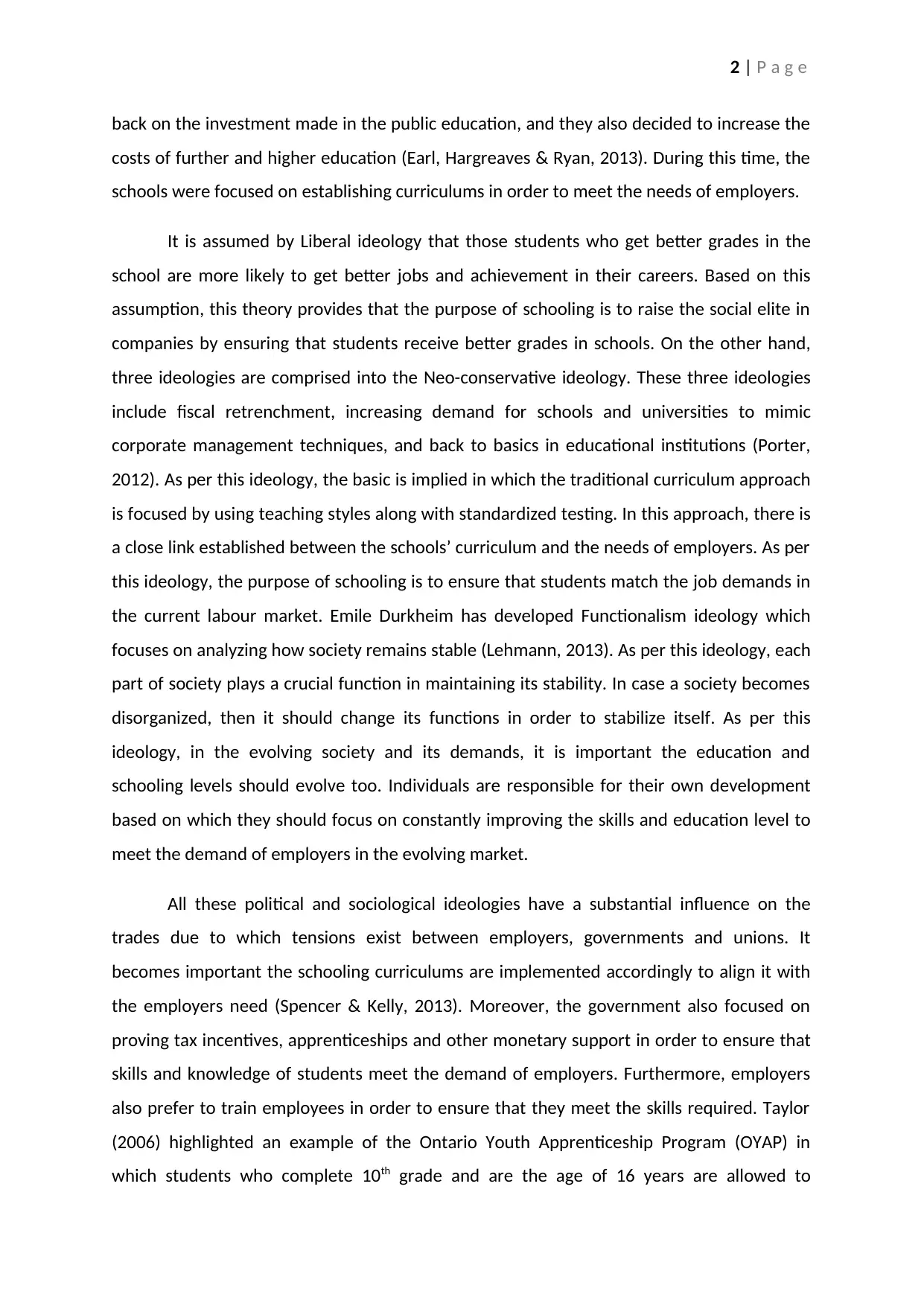
2 | P a g e
back on the investment made in the public education, and they also decided to increase the
costs of further and higher education (Earl, Hargreaves & Ryan, 2013). During this time, the
schools were focused on establishing curriculums in order to meet the needs of employers.
It is assumed by Liberal ideology that those students who get better grades in the
school are more likely to get better jobs and achievement in their careers. Based on this
assumption, this theory provides that the purpose of schooling is to raise the social elite in
companies by ensuring that students receive better grades in schools. On the other hand,
three ideologies are comprised into the Neo-conservative ideology. These three ideologies
include fiscal retrenchment, increasing demand for schools and universities to mimic
corporate management techniques, and back to basics in educational institutions (Porter,
2012). As per this ideology, the basic is implied in which the traditional curriculum approach
is focused by using teaching styles along with standardized testing. In this approach, there is
a close link established between the schools’ curriculum and the needs of employers. As per
this ideology, the purpose of schooling is to ensure that students match the job demands in
the current labour market. Emile Durkheim has developed Functionalism ideology which
focuses on analyzing how society remains stable (Lehmann, 2013). As per this ideology, each
part of society plays a crucial function in maintaining its stability. In case a society becomes
disorganized, then it should change its functions in order to stabilize itself. As per this
ideology, in the evolving society and its demands, it is important the education and
schooling levels should evolve too. Individuals are responsible for their own development
based on which they should focus on constantly improving the skills and education level to
meet the demand of employers in the evolving market.
All these political and sociological ideologies have a substantial influence on the
trades due to which tensions exist between employers, governments and unions. It
becomes important the schooling curriculums are implemented accordingly to align it with
the employers need (Spencer & Kelly, 2013). Moreover, the government also focused on
proving tax incentives, apprenticeships and other monetary support in order to ensure that
skills and knowledge of students meet the demand of employers. Furthermore, employers
also prefer to train employees in order to ensure that they meet the skills required. Taylor
(2006) highlighted an example of the Ontario Youth Apprenticeship Program (OYAP) in
which students who complete 10th grade and are the age of 16 years are allowed to
back on the investment made in the public education, and they also decided to increase the
costs of further and higher education (Earl, Hargreaves & Ryan, 2013). During this time, the
schools were focused on establishing curriculums in order to meet the needs of employers.
It is assumed by Liberal ideology that those students who get better grades in the
school are more likely to get better jobs and achievement in their careers. Based on this
assumption, this theory provides that the purpose of schooling is to raise the social elite in
companies by ensuring that students receive better grades in schools. On the other hand,
three ideologies are comprised into the Neo-conservative ideology. These three ideologies
include fiscal retrenchment, increasing demand for schools and universities to mimic
corporate management techniques, and back to basics in educational institutions (Porter,
2012). As per this ideology, the basic is implied in which the traditional curriculum approach
is focused by using teaching styles along with standardized testing. In this approach, there is
a close link established between the schools’ curriculum and the needs of employers. As per
this ideology, the purpose of schooling is to ensure that students match the job demands in
the current labour market. Emile Durkheim has developed Functionalism ideology which
focuses on analyzing how society remains stable (Lehmann, 2013). As per this ideology, each
part of society plays a crucial function in maintaining its stability. In case a society becomes
disorganized, then it should change its functions in order to stabilize itself. As per this
ideology, in the evolving society and its demands, it is important the education and
schooling levels should evolve too. Individuals are responsible for their own development
based on which they should focus on constantly improving the skills and education level to
meet the demand of employers in the evolving market.
All these political and sociological ideologies have a substantial influence on the
trades due to which tensions exist between employers, governments and unions. It
becomes important the schooling curriculums are implemented accordingly to align it with
the employers need (Spencer & Kelly, 2013). Moreover, the government also focused on
proving tax incentives, apprenticeships and other monetary support in order to ensure that
skills and knowledge of students meet the demand of employers. Furthermore, employers
also prefer to train employees in order to ensure that they meet the skills required. Taylor
(2006) highlighted an example of the Ontario Youth Apprenticeship Program (OYAP) in
which students who complete 10th grade and are the age of 16 years are allowed to
⊘ This is a preview!⊘
Do you want full access?
Subscribe today to unlock all pages.

Trusted by 1+ million students worldwide
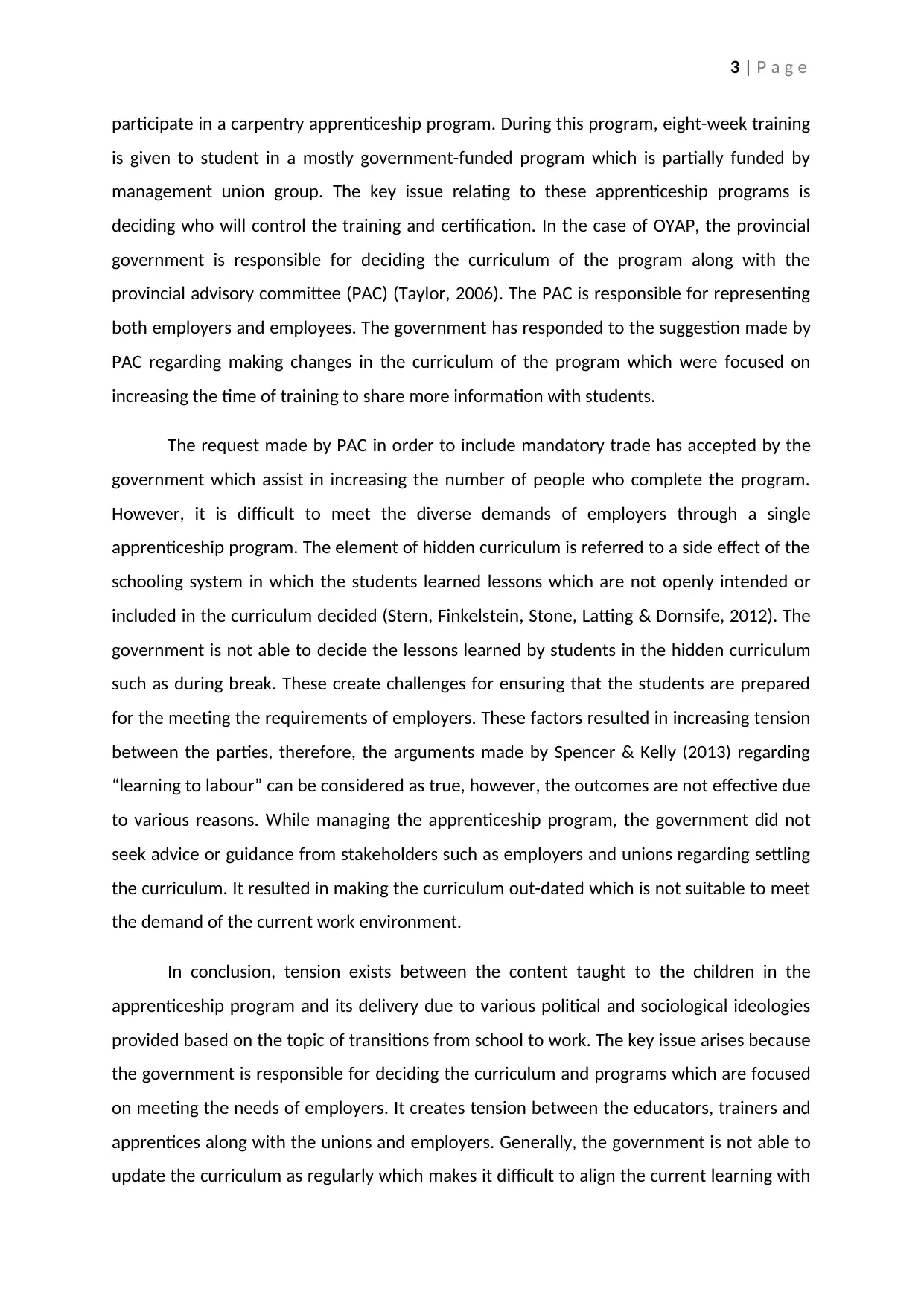
3 | P a g e
participate in a carpentry apprenticeship program. During this program, eight-week training
is given to student in a mostly government-funded program which is partially funded by
management union group. The key issue relating to these apprenticeship programs is
deciding who will control the training and certification. In the case of OYAP, the provincial
government is responsible for deciding the curriculum of the program along with the
provincial advisory committee (PAC) (Taylor, 2006). The PAC is responsible for representing
both employers and employees. The government has responded to the suggestion made by
PAC regarding making changes in the curriculum of the program which were focused on
increasing the time of training to share more information with students.
The request made by PAC in order to include mandatory trade has accepted by the
government which assist in increasing the number of people who complete the program.
However, it is difficult to meet the diverse demands of employers through a single
apprenticeship program. The element of hidden curriculum is referred to a side effect of the
schooling system in which the students learned lessons which are not openly intended or
included in the curriculum decided (Stern, Finkelstein, Stone, Latting & Dornsife, 2012). The
government is not able to decide the lessons learned by students in the hidden curriculum
such as during break. These create challenges for ensuring that the students are prepared
for the meeting the requirements of employers. These factors resulted in increasing tension
between the parties, therefore, the arguments made by Spencer & Kelly (2013) regarding
“learning to labour” can be considered as true, however, the outcomes are not effective due
to various reasons. While managing the apprenticeship program, the government did not
seek advice or guidance from stakeholders such as employers and unions regarding settling
the curriculum. It resulted in making the curriculum out-dated which is not suitable to meet
the demand of the current work environment.
In conclusion, tension exists between the content taught to the children in the
apprenticeship program and its delivery due to various political and sociological ideologies
provided based on the topic of transitions from school to work. The key issue arises because
the government is responsible for deciding the curriculum and programs which are focused
on meeting the needs of employers. It creates tension between the educators, trainers and
apprentices along with the unions and employers. Generally, the government is not able to
update the curriculum as regularly which makes it difficult to align the current learning with
participate in a carpentry apprenticeship program. During this program, eight-week training
is given to student in a mostly government-funded program which is partially funded by
management union group. The key issue relating to these apprenticeship programs is
deciding who will control the training and certification. In the case of OYAP, the provincial
government is responsible for deciding the curriculum of the program along with the
provincial advisory committee (PAC) (Taylor, 2006). The PAC is responsible for representing
both employers and employees. The government has responded to the suggestion made by
PAC regarding making changes in the curriculum of the program which were focused on
increasing the time of training to share more information with students.
The request made by PAC in order to include mandatory trade has accepted by the
government which assist in increasing the number of people who complete the program.
However, it is difficult to meet the diverse demands of employers through a single
apprenticeship program. The element of hidden curriculum is referred to a side effect of the
schooling system in which the students learned lessons which are not openly intended or
included in the curriculum decided (Stern, Finkelstein, Stone, Latting & Dornsife, 2012). The
government is not able to decide the lessons learned by students in the hidden curriculum
such as during break. These create challenges for ensuring that the students are prepared
for the meeting the requirements of employers. These factors resulted in increasing tension
between the parties, therefore, the arguments made by Spencer & Kelly (2013) regarding
“learning to labour” can be considered as true, however, the outcomes are not effective due
to various reasons. While managing the apprenticeship program, the government did not
seek advice or guidance from stakeholders such as employers and unions regarding settling
the curriculum. It resulted in making the curriculum out-dated which is not suitable to meet
the demand of the current work environment.
In conclusion, tension exists between the content taught to the children in the
apprenticeship program and its delivery due to various political and sociological ideologies
provided based on the topic of transitions from school to work. The key issue arises because
the government is responsible for deciding the curriculum and programs which are focused
on meeting the needs of employers. It creates tension between the educators, trainers and
apprentices along with the unions and employers. Generally, the government is not able to
update the curriculum as regularly which makes it difficult to align the current learning with
Paraphrase This Document
Need a fresh take? Get an instant paraphrase of this document with our AI Paraphraser
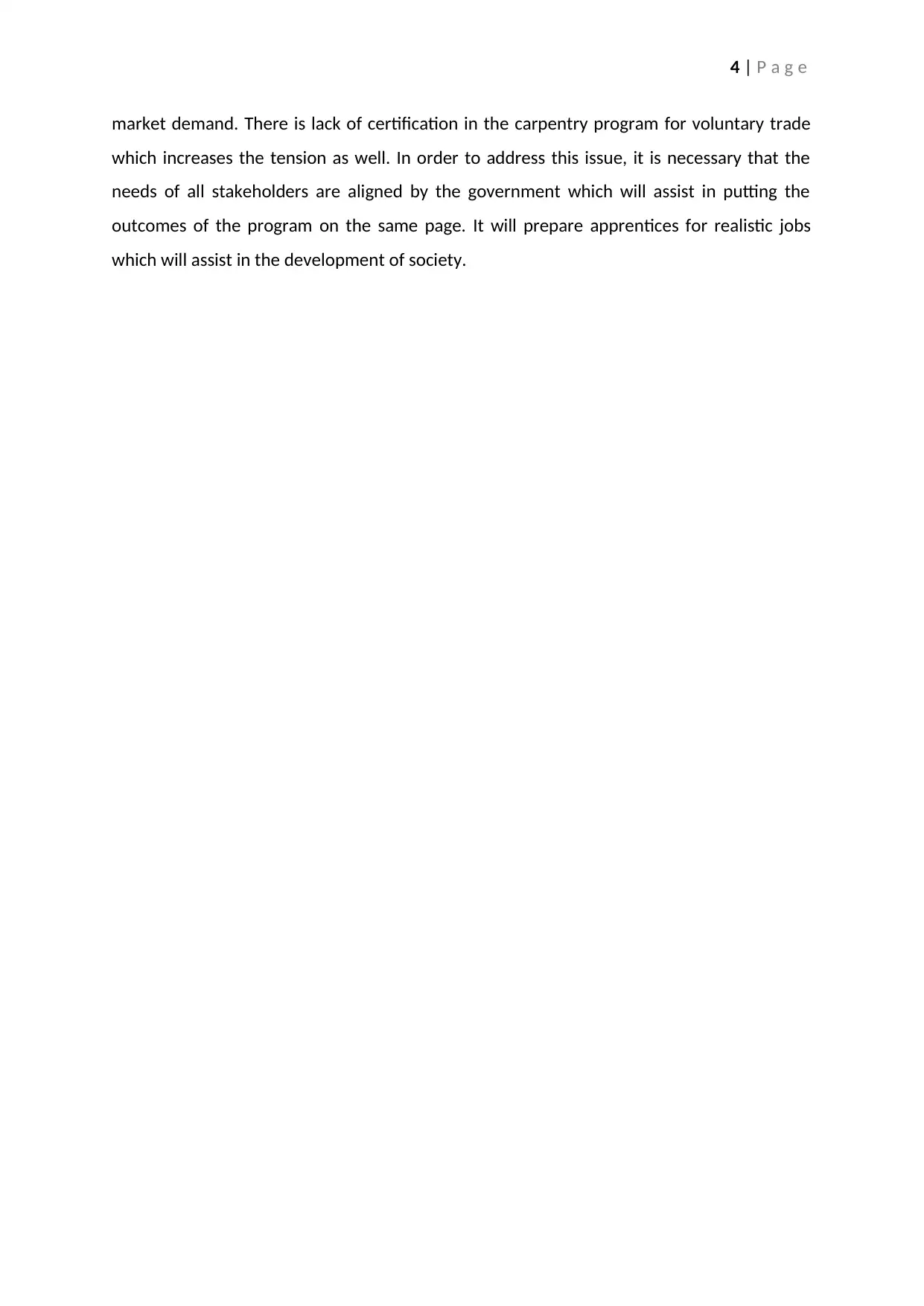
4 | P a g e
market demand. There is lack of certification in the carpentry program for voluntary trade
which increases the tension as well. In order to address this issue, it is necessary that the
needs of all stakeholders are aligned by the government which will assist in putting the
outcomes of the program on the same page. It will prepare apprentices for realistic jobs
which will assist in the development of society.
market demand. There is lack of certification in the carpentry program for voluntary trade
which increases the tension as well. In order to address this issue, it is necessary that the
needs of all stakeholders are aligned by the government which will assist in putting the
outcomes of the program on the same page. It will prepare apprentices for realistic jobs
which will assist in the development of society.
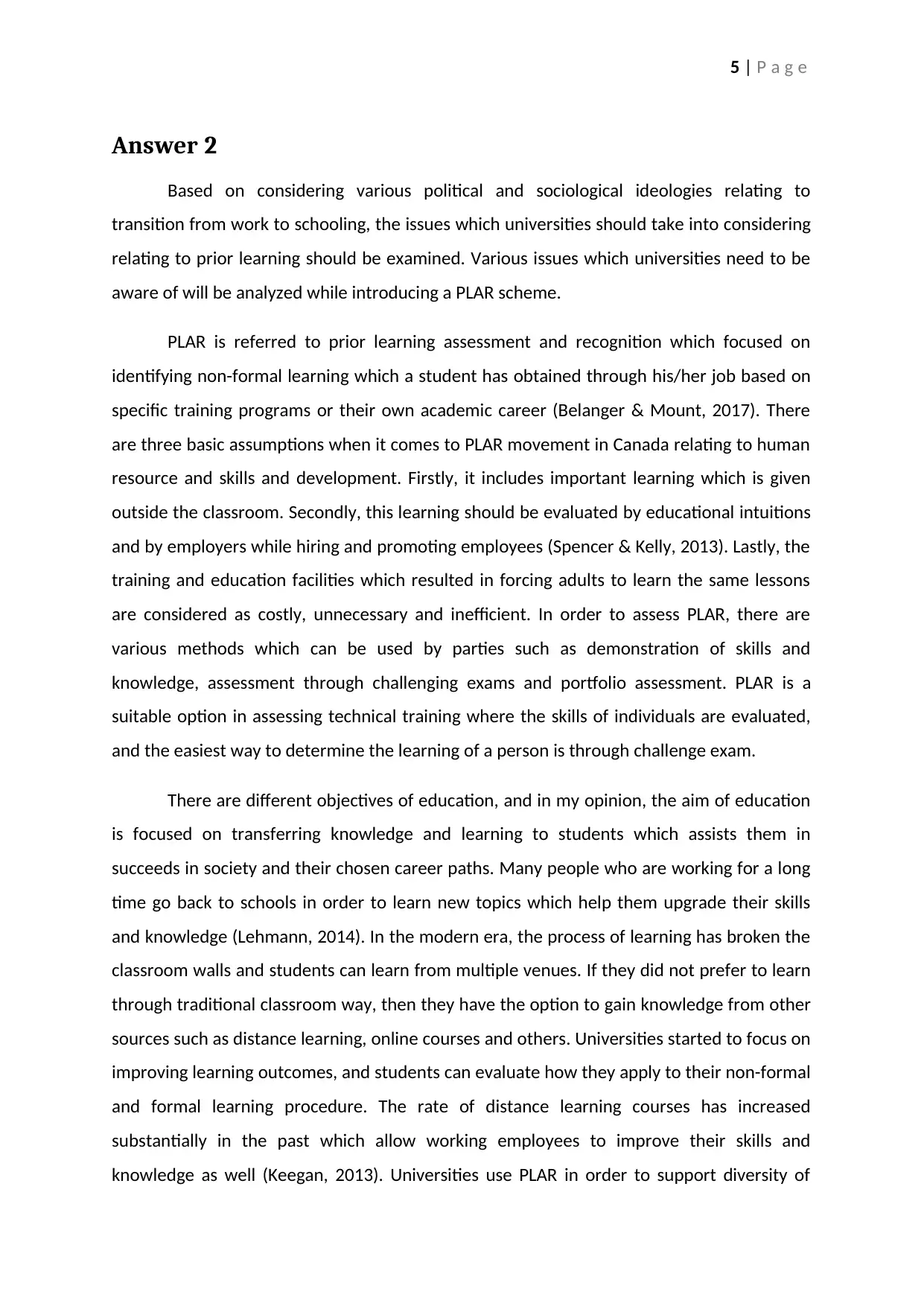
5 | P a g e
Answer 2
Based on considering various political and sociological ideologies relating to
transition from work to schooling, the issues which universities should take into considering
relating to prior learning should be examined. Various issues which universities need to be
aware of will be analyzed while introducing a PLAR scheme.
PLAR is referred to prior learning assessment and recognition which focused on
identifying non-formal learning which a student has obtained through his/her job based on
specific training programs or their own academic career (Belanger & Mount, 2017). There
are three basic assumptions when it comes to PLAR movement in Canada relating to human
resource and skills and development. Firstly, it includes important learning which is given
outside the classroom. Secondly, this learning should be evaluated by educational intuitions
and by employers while hiring and promoting employees (Spencer & Kelly, 2013). Lastly, the
training and education facilities which resulted in forcing adults to learn the same lessons
are considered as costly, unnecessary and inefficient. In order to assess PLAR, there are
various methods which can be used by parties such as demonstration of skills and
knowledge, assessment through challenging exams and portfolio assessment. PLAR is a
suitable option in assessing technical training where the skills of individuals are evaluated,
and the easiest way to determine the learning of a person is through challenge exam.
There are different objectives of education, and in my opinion, the aim of education
is focused on transferring knowledge and learning to students which assists them in
succeeds in society and their chosen career paths. Many people who are working for a long
time go back to schools in order to learn new topics which help them upgrade their skills
and knowledge (Lehmann, 2014). In the modern era, the process of learning has broken the
classroom walls and students can learn from multiple venues. If they did not prefer to learn
through traditional classroom way, then they have the option to gain knowledge from other
sources such as distance learning, online courses and others. Universities started to focus on
improving learning outcomes, and students can evaluate how they apply to their non-formal
and formal learning procedure. The rate of distance learning courses has increased
substantially in the past which allow working employees to improve their skills and
knowledge as well (Keegan, 2013). Universities use PLAR in order to support diversity of
Answer 2
Based on considering various political and sociological ideologies relating to
transition from work to schooling, the issues which universities should take into considering
relating to prior learning should be examined. Various issues which universities need to be
aware of will be analyzed while introducing a PLAR scheme.
PLAR is referred to prior learning assessment and recognition which focused on
identifying non-formal learning which a student has obtained through his/her job based on
specific training programs or their own academic career (Belanger & Mount, 2017). There
are three basic assumptions when it comes to PLAR movement in Canada relating to human
resource and skills and development. Firstly, it includes important learning which is given
outside the classroom. Secondly, this learning should be evaluated by educational intuitions
and by employers while hiring and promoting employees (Spencer & Kelly, 2013). Lastly, the
training and education facilities which resulted in forcing adults to learn the same lessons
are considered as costly, unnecessary and inefficient. In order to assess PLAR, there are
various methods which can be used by parties such as demonstration of skills and
knowledge, assessment through challenging exams and portfolio assessment. PLAR is a
suitable option in assessing technical training where the skills of individuals are evaluated,
and the easiest way to determine the learning of a person is through challenge exam.
There are different objectives of education, and in my opinion, the aim of education
is focused on transferring knowledge and learning to students which assists them in
succeeds in society and their chosen career paths. Many people who are working for a long
time go back to schools in order to learn new topics which help them upgrade their skills
and knowledge (Lehmann, 2014). In the modern era, the process of learning has broken the
classroom walls and students can learn from multiple venues. If they did not prefer to learn
through traditional classroom way, then they have the option to gain knowledge from other
sources such as distance learning, online courses and others. Universities started to focus on
improving learning outcomes, and students can evaluate how they apply to their non-formal
and formal learning procedure. The rate of distance learning courses has increased
substantially in the past which allow working employees to improve their skills and
knowledge as well (Keegan, 2013). Universities use PLAR in order to support diversity of
⊘ This is a preview!⊘
Do you want full access?
Subscribe today to unlock all pages.

Trusted by 1+ million students worldwide
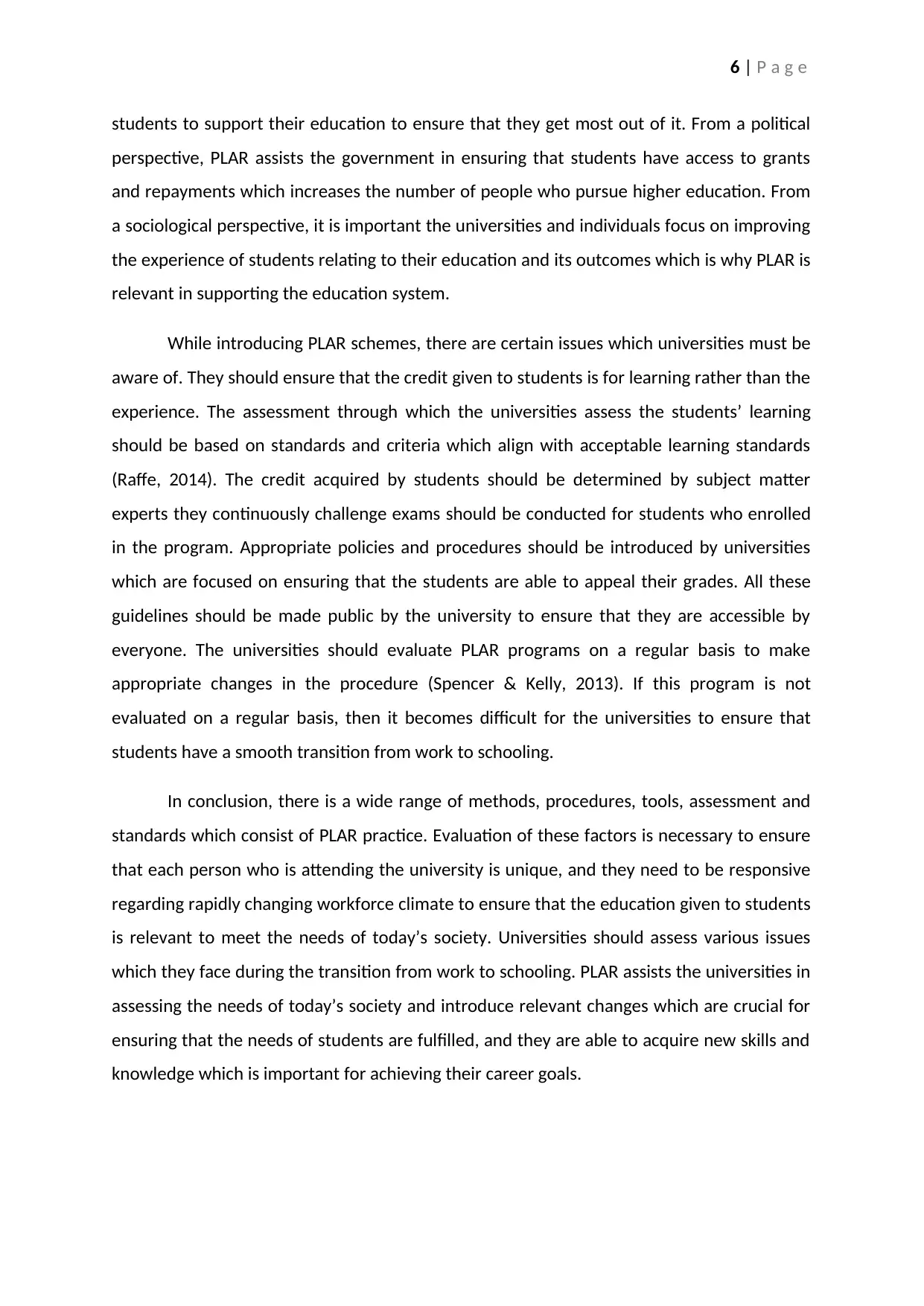
6 | P a g e
students to support their education to ensure that they get most out of it. From a political
perspective, PLAR assists the government in ensuring that students have access to grants
and repayments which increases the number of people who pursue higher education. From
a sociological perspective, it is important the universities and individuals focus on improving
the experience of students relating to their education and its outcomes which is why PLAR is
relevant in supporting the education system.
While introducing PLAR schemes, there are certain issues which universities must be
aware of. They should ensure that the credit given to students is for learning rather than the
experience. The assessment through which the universities assess the students’ learning
should be based on standards and criteria which align with acceptable learning standards
(Raffe, 2014). The credit acquired by students should be determined by subject matter
experts they continuously challenge exams should be conducted for students who enrolled
in the program. Appropriate policies and procedures should be introduced by universities
which are focused on ensuring that the students are able to appeal their grades. All these
guidelines should be made public by the university to ensure that they are accessible by
everyone. The universities should evaluate PLAR programs on a regular basis to make
appropriate changes in the procedure (Spencer & Kelly, 2013). If this program is not
evaluated on a regular basis, then it becomes difficult for the universities to ensure that
students have a smooth transition from work to schooling.
In conclusion, there is a wide range of methods, procedures, tools, assessment and
standards which consist of PLAR practice. Evaluation of these factors is necessary to ensure
that each person who is attending the university is unique, and they need to be responsive
regarding rapidly changing workforce climate to ensure that the education given to students
is relevant to meet the needs of today’s society. Universities should assess various issues
which they face during the transition from work to schooling. PLAR assists the universities in
assessing the needs of today’s society and introduce relevant changes which are crucial for
ensuring that the needs of students are fulfilled, and they are able to acquire new skills and
knowledge which is important for achieving their career goals.
students to support their education to ensure that they get most out of it. From a political
perspective, PLAR assists the government in ensuring that students have access to grants
and repayments which increases the number of people who pursue higher education. From
a sociological perspective, it is important the universities and individuals focus on improving
the experience of students relating to their education and its outcomes which is why PLAR is
relevant in supporting the education system.
While introducing PLAR schemes, there are certain issues which universities must be
aware of. They should ensure that the credit given to students is for learning rather than the
experience. The assessment through which the universities assess the students’ learning
should be based on standards and criteria which align with acceptable learning standards
(Raffe, 2014). The credit acquired by students should be determined by subject matter
experts they continuously challenge exams should be conducted for students who enrolled
in the program. Appropriate policies and procedures should be introduced by universities
which are focused on ensuring that the students are able to appeal their grades. All these
guidelines should be made public by the university to ensure that they are accessible by
everyone. The universities should evaluate PLAR programs on a regular basis to make
appropriate changes in the procedure (Spencer & Kelly, 2013). If this program is not
evaluated on a regular basis, then it becomes difficult for the universities to ensure that
students have a smooth transition from work to schooling.
In conclusion, there is a wide range of methods, procedures, tools, assessment and
standards which consist of PLAR practice. Evaluation of these factors is necessary to ensure
that each person who is attending the university is unique, and they need to be responsive
regarding rapidly changing workforce climate to ensure that the education given to students
is relevant to meet the needs of today’s society. Universities should assess various issues
which they face during the transition from work to schooling. PLAR assists the universities in
assessing the needs of today’s society and introduce relevant changes which are crucial for
ensuring that the needs of students are fulfilled, and they are able to acquire new skills and
knowledge which is important for achieving their career goals.
Paraphrase This Document
Need a fresh take? Get an instant paraphrase of this document with our AI Paraphraser
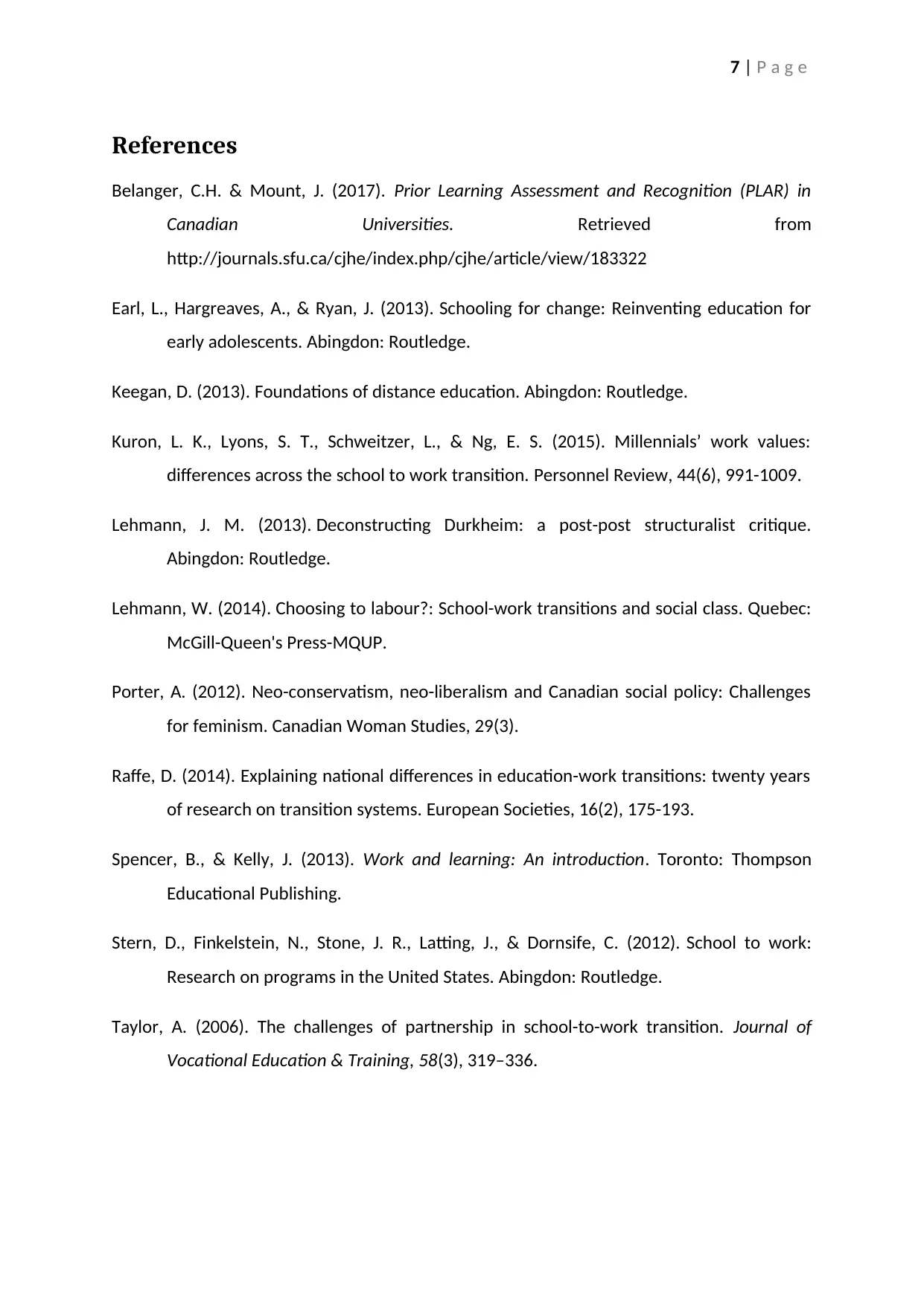
7 | P a g e
References
Belanger, C.H. & Mount, J. (2017). Prior Learning Assessment and Recognition (PLAR) in
Canadian Universities. Retrieved from
http://journals.sfu.ca/cjhe/index.php/cjhe/article/view/183322
Earl, L., Hargreaves, A., & Ryan, J. (2013). Schooling for change: Reinventing education for
early adolescents. Abingdon: Routledge.
Keegan, D. (2013). Foundations of distance education. Abingdon: Routledge.
Kuron, L. K., Lyons, S. T., Schweitzer, L., & Ng, E. S. (2015). Millennials’ work values:
differences across the school to work transition. Personnel Review, 44(6), 991-1009.
Lehmann, J. M. (2013). Deconstructing Durkheim: a post-post structuralist critique.
Abingdon: Routledge.
Lehmann, W. (2014). Choosing to labour?: School-work transitions and social class. Quebec:
McGill-Queen's Press-MQUP.
Porter, A. (2012). Neo-conservatism, neo-liberalism and Canadian social policy: Challenges
for feminism. Canadian Woman Studies, 29(3).
Raffe, D. (2014). Explaining national differences in education-work transitions: twenty years
of research on transition systems. European Societies, 16(2), 175-193.
Spencer, B., & Kelly, J. (2013). Work and learning: An introduction. Toronto: Thompson
Educational Publishing.
Stern, D., Finkelstein, N., Stone, J. R., Latting, J., & Dornsife, C. (2012). School to work:
Research on programs in the United States. Abingdon: Routledge.
Taylor, A. (2006). The challenges of partnership in school-to-work transition. Journal of
Vocational Education & Training, 58(3), 319–336.
References
Belanger, C.H. & Mount, J. (2017). Prior Learning Assessment and Recognition (PLAR) in
Canadian Universities. Retrieved from
http://journals.sfu.ca/cjhe/index.php/cjhe/article/view/183322
Earl, L., Hargreaves, A., & Ryan, J. (2013). Schooling for change: Reinventing education for
early adolescents. Abingdon: Routledge.
Keegan, D. (2013). Foundations of distance education. Abingdon: Routledge.
Kuron, L. K., Lyons, S. T., Schweitzer, L., & Ng, E. S. (2015). Millennials’ work values:
differences across the school to work transition. Personnel Review, 44(6), 991-1009.
Lehmann, J. M. (2013). Deconstructing Durkheim: a post-post structuralist critique.
Abingdon: Routledge.
Lehmann, W. (2014). Choosing to labour?: School-work transitions and social class. Quebec:
McGill-Queen's Press-MQUP.
Porter, A. (2012). Neo-conservatism, neo-liberalism and Canadian social policy: Challenges
for feminism. Canadian Woman Studies, 29(3).
Raffe, D. (2014). Explaining national differences in education-work transitions: twenty years
of research on transition systems. European Societies, 16(2), 175-193.
Spencer, B., & Kelly, J. (2013). Work and learning: An introduction. Toronto: Thompson
Educational Publishing.
Stern, D., Finkelstein, N., Stone, J. R., Latting, J., & Dornsife, C. (2012). School to work:
Research on programs in the United States. Abingdon: Routledge.
Taylor, A. (2006). The challenges of partnership in school-to-work transition. Journal of
Vocational Education & Training, 58(3), 319–336.
1 out of 8
Your All-in-One AI-Powered Toolkit for Academic Success.
+13062052269
info@desklib.com
Available 24*7 on WhatsApp / Email
![[object Object]](/_next/static/media/star-bottom.7253800d.svg)
Unlock your academic potential
Copyright © 2020–2025 A2Z Services. All Rights Reserved. Developed and managed by ZUCOL.